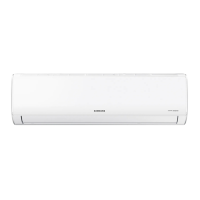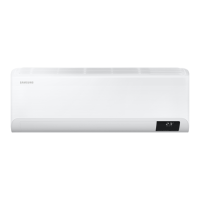8
User manual/
Installation manual
● For the product that uses the R-32 refrigerant, Install the indoor unit on the wall 1.8 m or higher from
the oor.
Preparation of re extinguisher
● If a hot work is to be done, an appropriate re extinguishing equipment should have been available.
● A dry powder or CO
2
re extinguisher shall be equipped near the charging area.
Ignition sources free
● Make sure to store the units in a place without continuously operating ignition sources (for example,
open ames, an operating gas appliance or an operating electric heater).
● The service engineers shall not use any ignition sources with the risk of re or explosion.
● Potential ignition sources shall be kept away from the work area where the ammable refrigerant can
possibly be released to the surrounding.
● The work area should be checked to ensure that there are no ammable hazards or ignition risks. The
“No Smoking” sign shall be attached.
● Under no circumstances shall potential sources of ignition be used while in detection of leakage.
● Make sure that the seals or sealing materials have not degraded.
● Safe parts are the ones with which the worker can work in a ammable atmosphere. Other parts may
result in ignition due to leakage.
● Replace components only with parts specied by Samsung. Other parts may result in the ignition of
refrigerant in the atmosphere from a leak.
Area ventilation
● Make sure that the work area is well ventilated before performing a hot work.
● Ventilation shall be made even during the work.
● The ventilation should safely disperse any released gases and preferably expel them into the
atmosphere.
● Ventilation shall be made even during the work.
Leakage detection methods
● The leakage detector shall be calibrated in a refrigerant-free area.
● Make sure that the detector is not a potential source of ignition.
● The leakage detector shall be set to the LFL (lower ammability limit).
● The use of detergents containing chlorine shall be avoided for cleaning because the chlorine may
react with the refrigerant and corrode the pipings.
● If leakage is suspected, naked ames shall be removed.
● If a leakage is found while in brazing, the entire refrigerant shall be recovered from the product or
isolated (e.g. using shut-off valves). It shall not be directly released to the environment. Oxygen free
nitrogen (OFN) shall be used for purging the system before and during the brazing process.
● The work area shall be checked with an appropriate refrigerant detector before and during work.
● Ensure that the leakage detector is appropriate for use with ammable refrigerants.
Labelling
● The parts shall be labelled to ensure that they have been decommissioned and emptied of refrigerant.
● The labels shall be dated.
● Make sure that the labels are afxed on the system to notify it contains ammable refrigerant.
Recovery
● When removing refrigerant from the system for servicing or decommissioning, it is recommended to
remove the entire refrigerant.
● When transferring refrigerant into cylinders, make sure that only the refrigerant recovery cylinders are
used.
● All cylinders used for the recovered refrigerant shall be labelled.

